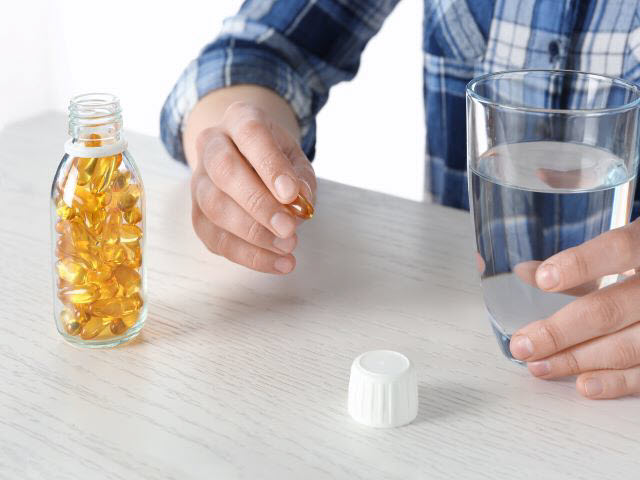- Home
- Blog
- Healthy Eating for Wellness
- Oxidation and rancidity in fish oils
Oxidation and rancidity in fish oils
Written by Catherine Saxelby
on Wednesday, 19 August 2020.
Tagged: fish oil, health, healthy cooking, healthy eating, healthy lifestyle, nutrition, omega-3

All oils are susceptible to oxidation, and fish oils are no exception. Unlike fresh fish, it’s difficult to tell whether or not a supplement is rancid. The only way I know is to slice open a fish oil capsule and if it smells odd, don’t take it. Ideally it should have a ‘normal’ fishy odour and be pale yellow in colour.
If the oil becomes oxidised (which can happen after exposure to heat, ultraviolet light, heavy metals or air during processing), it can become rancid, making it more likely to cause inflammation in the body. Not something you want! Mostly this rancidity is controlled by the addition of antioxidants such as tocopherols (vitamin E) and by the processing itself which is designed to minimise any contact with oxygen in the air.
What actually is fish oil?
Fish oil is extracted from the flesh and skin of oily fish such as anchovy, salmon, tuna, herring, cod and menhaden (a Northern hemisphere fish species). Generally natural antioxidants, like tocopherols which are collectively known as vitamin E, are added to protect the oil from oxidative damage, which ensures the unstable omega-3 fatty acids don’t deteriorate and become rancid.
The capsule itself, usually made from gelatin, is the main protection for the oil. Apart from fish oil, there are other minor ingredients which I also cover in my eBook "Fish Oils & Omega-3s”.
Freshness standards
In Australia, fish oil supplements are regulated by the Therapeutic Good Administration (TGA). The standard for natural fish oil, for instance, lists two criteria that specify a maximum of oxidation, namely that:
- the peroxide value must be less than 10 milliequivalents O2 per kg.
and
- the anisidine value must be less than 30.
Read more detail below.
How oxidation is measured
The Peroxide Value (PV) is the traditional and most widely used way to measure any oxidative degradation. It is considered a leading indicator. It determines the concentration of hydro-peroxide, the primary product of oxidation. The PV of an abused or air-exposed oil will rise over a few months.
The Peroxide Value must be less than 10 milliequivalents O2 per kg.
The Anisidine Value (or strictly, the para-Anisidine Value or p-AV) measures the breakdown products of peroxides, which is what gives the rancidity. The cascade of reactions that first produced the peroxides then shifts to produce conjugated dienes and trienes (related fat structures).
The Anisidine Value must be less than 30.
Any oil production aims to produce oils with peroxide values as low as possible, without the formation of any secondary reaction products. So, we want BOTH these values to be as low as possible.

Negative publicity and the real story
A lot of negative publicity about fish oil supplements being oxidised came from a single piece of research from 2014. This paper* claimed that of the 32 Australian and New Zealand fish oil brands tested, most did not contain the levels of EPA and DHA stated on the label and some had alarming levels of oxidation.
*Albert BB, Derraik JG, Cameron-Smith D, Hofman PL, Tumanov S, Villas-Boas SG, Garg ML, Cutfield WS. Fish oil supplements in New Zealand are highly oxidised and do not meet label content of n-3 PUFA. Sci Rep. 2015 Jan 21;5:7928. doi:10.1038/srep07928. Erratum in: Sci Rep. 2016 Nov 07;6:35092.
However, when these products were subsequently re-tested by credible researchers** including the CSIRO, the initial research was de-bunked once the correct testing methodologies were undertaken. Despite this, a fishy smell has hung around fish oil capsules – one that is not warranted.
** Nutrients Journal and PubMed Nichols PD, Dogan L, Sinclair A. Australian and New Zealand Fish Oil Products in 2016 Meet Label Omega-3 Claims and Are Not Oxidized. Nutrients. 2016; 8(11):70
Two factors to look for to ensure freshness and high quality
- Look for fish oil capsules that are intact and in containers that will not expose the capsules to light. Keep the capsules in the container and store them according to the recommendations on the pack. (I still put mine in the refrigerator for long term storage).
- Check the expiry date on the bottle or tub, particularly if you are buying in bulk, to ensure the supplement is still fresh by the time you consume it all.
Be realistic with your time frame – if you know you won’t take them all by the date they expire, it’s not a bargain. Don’t buy them.
The bottom line
Rest assured the fish oil capsules you buy according to the two guidelines above are NOT oxidised or rancid. This was a red herring (forgive the pun) designed to throw you off from their vast benefits.
I hope this short extract from my eBook "Fish Oils & Omega-3s” will help you understand what you’re reading if you see something about fish oil capsules being oxidised. If you want to learn more about fish oils and their uses, grab yourself a copy from the Foodwatch shop. It lists and explains the most common terms, compares popular brands of capsules and reveals the key considerations in choosing the most beneficial fish oil for you.
To buy your copy of the eBook, click here.
Foodwatch
The Good Stuff
The Boring Stuff
© 2025 Foodwatch Australia. All rights reserved
Website by Joomstore eCommerce





